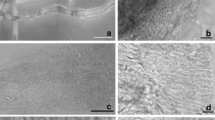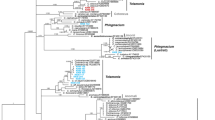Abstract
Belowground ectomycorrhizal communities are often species rich. Characterization of the ectomycorrhizas (ECMs) underneath native truffle areas and/or cultivation sites is particularly relevant to identifying fungal species that might interfere with or promote truffle propagation and fruiting. Fungal identification at the genus/species level can now be achieved by combining detailed morphological and anatomical descriptions with molecular approaches. In a survey of the mycorrhizal biodiversity of Tuber melanosporum orchards and inoculated host plants in nurseries, we repeatedly sampled ECMs with morphological features resembling those of the ECMs widely known as the AD type. Despite the fact that the AD type is regarded as one of the most competitive fungal species towards Tuber spp., its taxonomical rank has yet to be resolved. By analyzing the 28S and internal transcribed spacer (ITS) rDNA regions, here, we show that AD-type ECMs result from host plant colonization by the pyronemataceous species Trichophaea woolhopeia. Further to this, the 28S and ITS phylogenetic trees built from the AD-type ECMs analyzed sustain the hypothesis that T. woolhopeia is a species complex.



Similar content being viewed by others
References
Agerer R (1986) Colour Atlas of ectomycorrhizae. Einhorn, Schwäbisch-Gmünd
Agerer R (1991) Characterization of ectomycorrhiza. In: Norris JR, Read DJ, Varma AK (eds) Techniques for the study of mycorrhiza. Academic, London, pp 25–73
Agerer R (2001) Exploration types of ectomycorrhizae. Mycorrhiza 11:107–114
Agueda B, Agerer R, De Miguel AM, Parlade J (2008a) Querciriza quadratum + Quercus ilex L. Subsp ballota (Scop.) Desf. Samp. In: Agerer R, Danielson RM, Egli S, Ingleby K, Luoma D, Treu R (eds) Descriptions of ectomycorrhizae, vol 12. Einhorn-Verlag, Scwäbisch Gmünd, pp 113–123
Agueda B, Agerer R, De Miguel AM, Parlade J (2008b) Querciriza quadratum: a revision of the characters and identity of AD-type ectomycorrhiza. In Abstracts of Third International Spoleto Congress on Truffles. Spoleto 25–28 Nov 2008, p 39
Baciarelli Falini L, Rubini A, Riccioni C, Paolocci F (2006) Morphological and molecular analyses of ectomycorrhizal diversity in a man-made T. melanosporum plantation: description of novel truffle-like morphotypes. Mycorrhiza 16:475–484
Buée M, Reich M, Murat C, Morin E, Nilsson RH, Uroz S, Martin F (2009) 454 Pyrosequencing analyses of forest soils reveal an unexpectedly high fungal diversity. New Phytol 184:449–456
De Miguel AM, Sáez R (2005) Algunas micorrizas competidoras de plantaciones truferas. Publ Biol Univ Navarra, Ser Bot 16:1–18
Donnini D, Bencivenga M (1995) Micorrize inquinanti frequenti nelle piante tartufigene. Nota 2- inquinanti in campo. Micol Ital 2:185–207
Edgar RC (2004) MUSCLE: a multiple sequence alignment method with reduced time and space complexity. BMC Bioinformatics 5:113
Giraud M (1988) Prélévement et analyse de mycorhizes. Bull. FNTP, 10, 49–63. In: La Truffe. CTIFL, Paris
Granetti B, Angelini P (1992) Competizione tra alcuni funghi micorrizici e T. melanosporum Vitt. in una tartufaia coltivata. Micol Veget Mediterr 7:173–188
Granetti B, Baciarelli Falini L (1997) Competizione tra le micorrize di T. melanosporum Vitt. e quelle di altri funghi in una tartufaia coltivata a Quercus ilex L. Micol Ital 1:45–49
Guindon S, Gascuel O (2003) A simple, fast, and accurate algorithm to estimate large phylogenies by maximum likelihood. Syst Biol 52:696–704
Horton TR, Bruns TD (2001) The molecular revolution in ectomycorrhizal ecology: peeking into the black-box. Mol Ecol 10:1855–1871
Izzo AD, Agbowo J, Bruns TD (2005) Detection of plot-level changes in ectomycorrhizal communities across years in an old-growth mixed-conifer forest. New Phytol 166:619–630
Kimura M (1980) A simple method for estimating evolutionary rates of nucleotide substitution through comparative studies of nucleotide sequences. J Mol Evol 16:111–120
Kumar S, Tamura K, Jakobsen IB, Nei M (2001) MEGA 2: molecular evolutionary genetics analysis software. Arizona State University, Tempe
Luppi AM (1972) La microflora della rizosfera nelle tartufaie. III Analisi micologiche di terreni tartufiferi dell’Italia centrale. Allionia 22:105–113
Luppi AM, Fontana A (1977) Studi sull’ecologia del Tuber melanosporum. IV. Analisi micologiche di terreni tartufiferi francesi. Allionia 18:33–40
Mamoun M, Oliver JM (1997) Mycorrhizal inoculation of cloned hazels by Tuber melanosporum: effect of soil disinfestation and co-culture with Festuca ovina. Plant Soil 188:221–226
Moncalvo JM, Lutzoni FM, Rehner SA, Johnson J, Vilgalys R (2000) Phylogenetic relationships of agaric fungi based on nuclear large subunit ribosomal DNA sequences. Syst Biol 49:278–305
Nei M, Kumar S (2000) Molecular evolution and phylogenetics. Oxford University Press, New York
Paolocci F, Rubini A, Granetti B, Arcioni S (1999) Rapid molecular approach for a reliable identification of Tuber spp. ectomycorrhizae. FEMS Microbiol Ecol 28:23–30
Peay KG, Kennedy PG, Bruns TD (2008) Fungal community ecology: a hybrid beast with a molecular master. Bioscience 58:799–810
Perry BA, Hanseny K, Pfister DH (2007) A phylogenetic overview of the family Pyronemataceae (Ascomycota, Pezizales). Mycol Res 111:549–571
Posada D, Crandal KA (1998) Modeltest: testing the model of DNA substitution. Bioinformatics 14:817–818
Saitou N, Nei M (1987) The neighbor-joining method: a new method for reconstructing phylogenetic trees. Mol Bio Evol 4:406–425
Smith ME, Douhan GW, Rizzo DM (2007) Intra-specific and intra-sporocarp ITS variation of ectomycrrhizal fungi assessed by rDNA sequencing of sporocarps and pooled ectomycorrhizal roots from a Quercus woodland. Mycorrhiza 18:15–22
Sourzat P, Sanchez A, Ourzick A, Roux JJ (1999) Analyse du statut mycorhizien de brules steriles dans trois regions de France : Midi-Pyrenees (Lot), Paca (Var), Charente Poitou (Vienne). In Proceedings of the 5th International Congress on the Science and Cultivation of Truffle and Other Edible Hypogeous Mushrooms, Aix-en-Provence, France, 4–6 Mar 1999, pp 474–479
Tedersoo L, Köljalg U, Hallenberg N, Larsson K (2003) Fine scale distribution of ectomycorrhizal fungi and roots across substrate layers including course woody debris in a mixed forest. New Phytol 159:153–165
Tedersoo L, Hansen K, Perry BA, Kjøller R (2006) Molecular and morphological diversity of pezizalean ectomycorrhiza. New Phytol 170:581–596
White TJ, Bruns TD, Lee S, Taylor J (1990) Analysis of phylogenetic relationship by amplification and direct sequencing of ribosomal RNA genes. In: Innis MA, Gelfand DH, Sninsky JJ, White TJ (eds) PCR protocols: a guide to methods and applications. Academic, New York, pp 315–322
Acknowledgements
This study was partially founded by Regione Lazio (PRAL 2003–2005), Regione Umbria, and the Italian Ministry for the Environment.
Author information
Authors and Affiliations
Corresponding author
Electronic supplementary material
Below is the link to the electronic supplementary material.
Fig. S1
Multiple sequence alignment of the large subunit region. (DOC 61 kb)
Fig. S2
Multiple sequence alignment of the internal transcribed spacer region. (DOC 61 kb)
Fig. S3
Neighbor-joining tree based on large subunit sequences from AD-type samples and other Pyronemataceae. Numbers near the branches represent the bootstrap values (1,000 replicates). The sequences from AD-type samples obtained in this study are given in bold. (DOC 240 kb)
Fig. S4
Maximum-likelihood tree based on large subunit sequences from AD-type samples and other Pyronemataceae. Numbers near the branches represent the bootstrap values (1,000 replicates). The sequences from AD-type samples obtained in this study are given in bold. (DOC 241 kb)
Rights and permissions
About this article
Cite this article
Rubini, A., Belfiori, B., Passeri, V. et al. The AD-type ectomycorrhizas, one of the most common morphotypes present in truffle fields, result from fungi belonging to the Trichophaea woolhopeia species complex. Mycorrhiza 21, 17–25 (2011). https://doi.org/10.1007/s00572-010-0308-4
Received:
Accepted:
Published:
Issue Date:
DOI: https://doi.org/10.1007/s00572-010-0308-4




